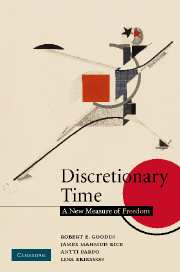Appendix 1 - Methodology
Published online by Cambridge University Press: 28 October 2009
Summary
Introductory notes
Table A1.1 describes the years and national currencies associated with particular countries. In the other tables in this appendix, all income variables are reported in the national currencies listed in this table. All time-use variables are reported in hours per week.
For the purposes of the procedures described in this appendix, adults are taken to be people aged 18 years or over. Children are taken to be people aged under 18 years.
Actual households
Actual time in personal care
Calculate a new diary day weight (DW), based on how many days of the week a diary day is designed to represent. For example, if each person completed a diary on one random day of the week, then for each diary day, DW is equal to 7. If each person completed diaries on two random days of the week, then for each diary day, DW is equal to 3.5. If each person completed a diary on one random weekday and a diary on one random weekend day, then for each weekday diary day, DW is equal to 5, while for each weekend diary day, DW is equal to 2.
For each diary day, calculate PECXX by summing ‘time for dressing/toilet’ (AV13), ‘time spent receiving personal services’ (AV14), ‘time spent eating meals and snacks’ (AV15) and ‘time spent sleeping/napping’ (AV16).
For each diary day, calculate PECX by multiplying PECXX by 1440 divided by the difference between 1440 and ‘time in unclassifiable, unrecorded, or unknown activities’ (AV41).
Split the data set into groups of diary days associated with each person.
[…]
Information
- Type
- Chapter
- Information
- Discretionary TimeA New Measure of Freedom, pp. 271 - 325Publisher: Cambridge University PressPrint publication year: 2008
